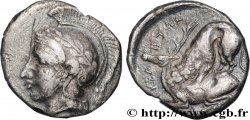v41_0027 - LUCANIA - VELIA Nomos, statère ou didrachme
MONNAIES 41 (2009)
起拍价 : 250.00 €
估价 : 380.00 €
竞价记录 : 250.00 €
起拍价 : 250.00 €
估价 : 380.00 €
竞价记录 : 250.00 €
种类 Nomos, statère ou didrachme
日期: c. 350/340 - 320/310 AC.
铸币厂名称/城市 Vélia
材质 silver
直径 20 mm
模子方针 3 h.
重量 7,29 g.
稀少度 R1
发行人: groupe VI, section 62
关于品相的说明
Exemplaire sur un flan large et bien centré des deux côtés. Usure importante, mais parfaitement lisible et identifiable. Jolie patine gris foncé
出版目录中的项代码 :
正面
正面的文字 ANÉPIGRAPHE ; MONOGRAMME DERRIÈRE LE CASQUE.
正面的说明书 Tête d'Athéna à gauche, coiffée du casque phrygien à cimier avec triple aigrette, orné d'un centaure.
正面铭文 KE
背面
背面的说明书 Lion passant à gauche, dévorant une proie.
背面铭文 [U]ELHTW[N]/ A KE
评论
De mêmes coins que les exemplaires de l’Ashmolean Museum d’Oxford (SNG Oxford, 1279 à 1281). La série 60 du classement de Williams se caractérise par un monogramme qui correspond à la signature du graveur Kléodoros. Sur cet exemplaire, on distingue très nettement un début de cassure de coin au droit devant le visage. Au revers, on remarque la présence de deux minuscules points devant l’antérieur et sous la queue. Très tôt, le monnayage de Vélia a été décrit comme ayant inspiré la drachme lourde de Marseille (LT. 785-791). Certains l’ont même décrit comme un monnayage symmachique : un lion de Vélia étant l’équivalent de deux lions de Marseille. Aujourd’hui, cette théorie est remise en cause.
Same dies as the examples in the Ashmolean Museum in Oxford (SNG Oxford, 1279 to 1281). Series 60 of the Williams classification is characterized by a monogram that corresponds to the signature of the engraver Kleodoros. On this example, we can clearly see the beginnings of a die break on the obverse in front of the face. On the reverse, we note the presence of two tiny dots in front of the fore-end and under the tail. Very early on, the coinage of Velia was described as having inspired the heavy drachma of Marseille (LT. 785-791). Some have even described it as a symmachic coinage: one lion of Velia being the equivalent of two lions of Marseille. Today, this theory is being challenged
Same dies as the examples in the Ashmolean Museum in Oxford (SNG Oxford, 1279 to 1281). Series 60 of the Williams classification is characterized by a monogram that corresponds to the signature of the engraver Kleodoros. On this example, we can clearly see the beginnings of a die break on the obverse in front of the face. On the reverse, we note the presence of two tiny dots in front of the fore-end and under the tail. Very early on, the coinage of Velia was described as having inspired the heavy drachma of Marseille (LT. 785-791). Some have even described it as a symmachic coinage: one lion of Velia being the equivalent of two lions of Marseille. Today, this theory is being challenged








 对产品描述纠错
对产品描述纠错 打印
打印 分享我的选择
分享我的选择 提问
提问 Consign / sell
Consign / sell
 产品介绍
产品介绍









